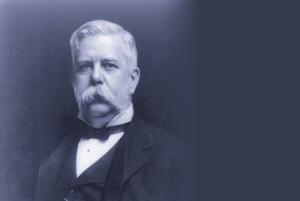It was Westinghouse that shortened the typical American work week from six days to five and a half.
On October 6, 1846, one of our industry’s greatest founders, George Westinghouse, was born in Central Bridge, New York. Just twenty-four miles from Schenectady, New York, which ultimately and ironically became the headquarters of Westinghouse’s chief rival, the Edison General Electric Company.

Westinghouse enlisted in the Union Army in 1863, serving with the 16th New York Volunteer Cavalry in the Civil War. The regiment was repeatedly in action in northern Virginia, fighting several engagements against the Confederate cavalry of John Mosby, known as the Gray Ghost.
He transferred to the Navy in late 1864 following the death of a brother killed in battle. Westinghouse received a commission as an engineering officer and was assigned to a new steamship, the U.S.S. Muscoota. In early May 1865, soon after Lee’s surrender at Appomattox Court House and Lincoln’s assassination, the Muscoota was dispatched to Key West. The Navy wanted to block the escape of Jefferson Davis, who had been the Confederacy’s president.
The next month, while still eighteen years old, engineering officer Westinghouse received a letter from his father. The young man had received his first patent, for a rotary steam engine.
Westinghouse became rich and famous for his invention four years later of air brakes for railroads. Shaping the energy industries came next.
In the mid-1880’s, being impressed by the large production of natural gas from a well on his property, he purchased a gas company. Westinghouse ultimately supplied gas to thousands of homes in Pittsburgh with an extensive pipeline network.
Westinghouse also became interested in electricity. He saw disadvantages in Thomas Edison’s direct current-based systems, preventing a grid of centralized power stations.
Now based in Pittsburgh, Westinghouse acquired exclusive rights to Nikola Tesla’s patent for the polyphase system. And lured the volatile inventor to western Pennsylvania to continue his work on alternating current motors.
Westinghouse won the prize contract to light Chicago’s Columbian Exposition in 1893. He manufactured over two hundred thousand lamps for lighting and replacements. The Westinghouse exhibit also included a complete working model of a polyphase system, including step-up and step-down transformers, a transmission line, and switch board.
At about the same time, Westinghouse was negotiating to supply alternating current generators, using hydropower at Niagara Falls, to electrify Buffalo, New York. Westinghouse became the successful bidder over six other companies. The historic system went commercial in fall 1895.
It was Westinghouse that shortened the typical American work week from six days to five and a half. The precedent was set when Westinghouse’s employees were allowed to go home mid-day Saturday.
On October 5, 1874, Charles Merz was born in Newcastle upon Tyne, England. Merz pioneered alternating current systems in the U.K. His first major system was opened by Lord Kelvin himself, near Newcastle, six years after the electrification of Buffalo by Westinghouse.
Later, Merz led the efforts that eventually caused Parliament to establish National Grid. At age sixty-six, after designing the electric drive for a world war two tank, he and his two children were killed in the London Blitz.
On October 31, 1847, Galileo Ferraris, was born in Livorno Vercellese, Kingdom of Sardinia (an Italian island). His work on polyphase systems was virtually simultaneous with that of Tesla.
On October 3, 1869, Paul Boucherot was born in Paris, France. His work laid the foundation for our understanding of reactive power.
On October 18, 1847, Alexander Lodygin was born in Tambov Governorate, Russia. He arguably invented the incandescent light bulb before Edison, though he wasn’t Edison’s equal at popularizing electricity. However, Lodygin did patent and profit from his invention of the incandescent bulb’s tungsten filament.



